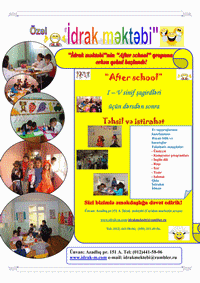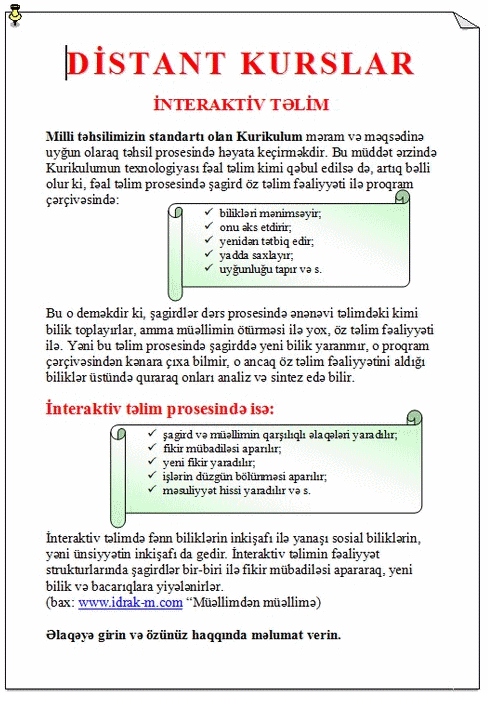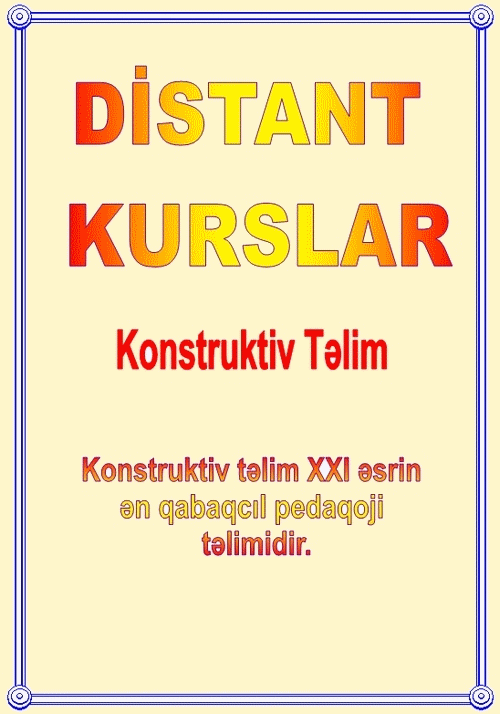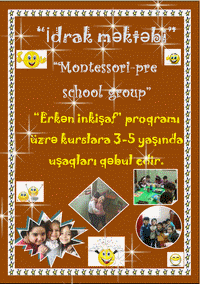Logic of integrity, fuzzy logic and knowledge modeling for machine education
Fatma khanum Bunyatova,
principle of “Intellect school” Baki Azerbaijan
Abstract
This article deals with the modelling of learning meaningful knowledge for machine learning without teacher. Model of knowledge is built on logic integrity of Piaget and fuzzy logic of Zade.
Keywords: logic of integrity, fuzzy logic, natural and artificial intelligence, machine learning model, numeric properties
Fast development of ICT clearly shows how training is behind this development. Quick modification of process devices leaves far behind it hard on the modernization of education.
Though new directions in teaching how to e- learning, m-learning, learning on-line machine learning etc. were formed by ICT technical means, but these means are not yet in a position to influence the fundamental change in education. This is because educational principles existing more than 300 years of traditional learning, learning through private, unsystematic, inconsequent constructed knowledge were nested in these technical means. To turn the training in technology, in order to obtain the desired effectiveness, the following fundamental changes to done in learning: 1. To change the way learning; from the transfer of knowledge to the position of a learning process in which every student can construct their knowledge on the basis of their competency .
2. To model the structure of knowledge. This model should be similar models of natural and artificial intelligence. Model of natural intelligence was built by Piaget and artificial one by Zadeh.
3. To built on the basis of these two theories and fuzzy-logical holistic model of knowledge. This model can become psycho pedagogical and technologically based model for substantive knowledge of machine learning in all its tracks.
How can this be done and what will it give?
- Changing the method of learning means going from private methods to learning technologies. In this case, creative learning technology by Bunyatova is proposed. [5] This technology is based on cognitive theory of Piaget. Technology of constructive learning aims at developing learner’s intelligence structures, to organize their knowledge over intellectual activities. This intellectual activity of learners are carried out by means of thinking logical operations of Piaget (Piaget 2). Rationales and guidelines transform existing knowledge of learner in qualitatively new and create conditions for the generation.
- Substantive knowledge still
 appear as didactic unit of knowledge. They are being learned private and it takes years to reach to the integrity of knowledge. Instead of it, it is proposed to model the structure of knowledge integrity by tool of logic integrity of Piaget, in order knowledge of learners would be horizontally integrated into schema integrity [1]. In integrity-logic model of knowledge teaching units of knowledge understood as knowledge structures and they are built in integrity. From this holistic scheme knowledge is going to private knowledge, that is knowledge is going into logical structures or from private into holistic knowledge. Structure of knowledge in this mode are divided into variables and constants. Variables are categorical knowledge, constant knowledge is an invariant knowledge. This structure of knowledge is built isomorphically in structures of intelligence. This structure means genetic construction of knowledge and each student depending on their development may determine their level. Logically built structure knowledge may temporarily be disconnected, joined, associated, cancelled etc. All these mobile traffic patterns by logical operations of thinking as a classification, seriation, multiplicative operations and replacement.(3)
appear as didactic unit of knowledge. They are being learned private and it takes years to reach to the integrity of knowledge. Instead of it, it is proposed to model the structure of knowledge integrity by tool of logic integrity of Piaget, in order knowledge of learners would be horizontally integrated into schema integrity [1]. In integrity-logic model of knowledge teaching units of knowledge understood as knowledge structures and they are built in integrity. From this holistic scheme knowledge is going to private knowledge, that is knowledge is going into logical structures or from private into holistic knowledge. Structure of knowledge in this mode are divided into variables and constants. Variables are categorical knowledge, constant knowledge is an invariant knowledge. This structure of knowledge is built isomorphically in structures of intelligence. This structure means genetic construction of knowledge and each student depending on their development may determine their level. Logically built structure knowledge may temporarily be disconnected, joined, associated, cancelled etc. All these mobile traffic patterns by logical operations of thinking as a classification, seriation, multiplicative operations and replacement.(3) - Psychological concepts built by integrity logic model of a comprehensive subject knowledge are replaced by the concepts of fuzzy logic by Zadeh [4]. We get fuzzy-logic model of knowledge, because the essence of logic by Zadeh coincides with concepts of logic integrity by Piaget. The difference is only in languages: Piaget operated language of natural intelligence, but Zadeh operated artificial language. So the concepts of categorical knowledge or variable knowledge is replaced by the conception of linguistic variable by Zade. Proceeding from concepts of linguistic variable by Zade membership function corresponds to two rules:
1) syntactical, which is set in the form of a grammar that generates the title variable in the form of language categories.
2) semantic, which determines the procedure to compute the meaning of algorithmic each value. Fuzzy set based on linguistic knowledge can be represented as a vocabulary of the language. Fuzzy set membership function on, then the words will be interpreted in a lexical meaning.
How is model of subject knowledge built for machine learning?
To build a model of subject knowledge for machine learning without teachers, the followings to be done:
1. To divide the knowledge structure into variables i.e. linguistic variable and into invariant i.e. universal set.
2. Invariant or universal knowledge are indicated via X.
3. This knowledge is classified into classes or elements of a set and are built horizontally. Derived classes of invariant knowledge or values in the set are marked by x 0.1 … x 0, 9.
Invariant set of knowledge, or knowledge may be the ultimate relating to classification and endless within classes.
4. The variables, categorical knowledge or linguistic variable are arranged vertically and are marked via Y. They are also classified and identified through 0.1; 0.2, etc. In [Nordhausen and Langley, 1990] pointed out that a category is the basis for a unified theory of scientific research. Denoting the set of classes and groups, as well as categorical variable through the knowledge of the language, we can provide this knowledge with their properties. Each property accepts serial number. So, the sentence “The day was sunny”, can be set on the coordinate space as dots: XO, 1,1, YO, 1, X 0,5 Y,O4/1 XO,2 YO1/5. A linguistic variable – Y0. 1 is inherent for each element of the set, for example, X0,1. Numerical showing of x0,1,1 according to the rules of Russian grammar denotes masculine-noun; Y0, 1-denotes a single number, and etc. By analogy of these characters, you can construct many proposals based on existing knowledge. This property can be one of the justifications for unsupervised machine learning because it was derived from the example of natural language. Each class or element of knowledge is at the same time cluster structures of knowledge. They have their rules and patterns. Structure of knowledge clusters can logically be combined, temporarily disconnected, associated, cancelled by logical rules of the language variable settings. Belonging to linguistic variable multiple elements or to logical cluster is defined such logical operations like operation of replacement, enrichment, identical and multiplicative operations. That is, in this case as the rules of the language variable, the same rule set are in mobile movement, merged for a given installation around the logical structure of knowledge or changed into nanostructures.
What innovations can bring this model in ICT and education?
- Knowledge is seen in the integrity diagram. Because language is the means of communication and expression of thought , of course, the conditions of integrity and logic of Zadeh can be in any scientific knowledge and rules of Piaget logic and fuzzy logic can be applied to them.
- Structure of knowledge will be divided into the invariant and variable or syntactic and semantic. Numeric and categorical invariant properties of knowledge makes it possible to build knowledge through what coordinates would be the construction of knowledge.
- Thinking operation allows to collect knowledge structure thinking in clusters to ascertain their relationship and their relations, to classify them, enrich or replace the other structure. These logical operations gather as the magnet around structure knowledge related to the relevant knowledge and change it to nanostructure of knowledge.
- Logic integrity of Piaget and fuzzy logic of Zadeh destroy traditional vertical building knowledge structures and builds them into horizontal structure (5). Such building of knowledge settling in the psychology, education and high technology, in its turn, creates a nonopsychopedagogical approach in teaching.







